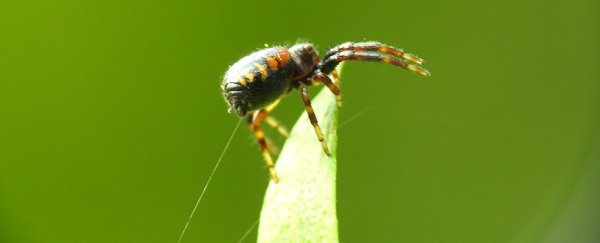Sometimes, when it rains or when they feel the urge to migrate, spiders get out their little silk knapsacks, and balloon away.
This ballooning behaviour is well understood by spider scientists, but researchers have recently discovered that electric fields can not only trigger the behaviour, but also provide lift – even without the slightest breeze.
"When one thinks of airborne organisms, spiders do not usually come to mind," explained researchers Erica Morley and Daniel Robert from the University of Bristol, in their paper.
"However, these wingless arthropods have been found 4 kilometres [2.5 miles] up in the sky, dispersing hundreds of kilometres."
They travel via the atmospheric potential gradient (APG), an electric circuit between Earth and the ionosphere - the part of Earth's upper atmosphere that's ionised by solar radiation.
Thunderstorms act like a giant battery for the APG, charging up and maintaining the electric fields in the atmosphere.
The researchers explain that the idea of ballooning behaviour being caused by this electric circuit was first floated in the 1800's, but had been dismissed not long after, without being tested.
"Charles Darwin mused over how thermals might provide the forces required for ballooning as he watched hundreds of spiders alight on the Beagle on a calm day out at sea," explained the researchers in the paper.
"Darwin's observation, however, did not provide further evidence in support."
In 2013 a different group of researchers put forward a theory that electric fields might be at least a part of spiders ballooning strategy, and Morley and Roberts were interested to see if the spiders actually responded to the electric fields and their fluctuations.
They caught spiders from the genius Erigone from a balloon trap, and set up an experiment without stimuli such as air movement or atmospheric electricity. Then they turned on an artificial electric field and watched what would happen.
The team did indeed find that the spiders went ballooning when the field was on, and the field's electrostatic forces alone were enough to power the movement; it's the same force that lifts up your hair if you rub a balloon on your head.
When the researchers switched off the electric field, the spiders would glide down; turning the field on made them move upwards (those spiders would have been so confused).
"We don't yet know whether electric fields are required to allow spider ballooning," says Morley. "We do, however, know that they are sufficient."
Spiders have sensory hairs called trichobothria that would move in response to the electric field, which the researchers believe is what the spiders use to detect the APG.
Although science has taught us so much, these sorts of studies show just how much there is left to learn about the tricks spiders have up their eight little sleeves.

The research has been published in Current Biology.
